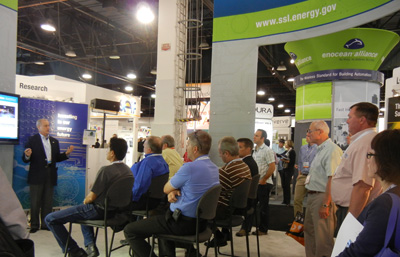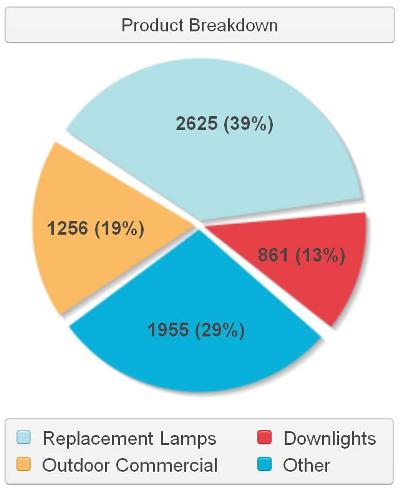LED Lighting Facts Rolls out QA Testing & More
The US Department of Energy's LED Lighting Facts program is evolving along with the changing marketplace. In 2011-12, LED Lighting Facts has added to its reporting capabilities and is instituting two product-integrity programs: a Quality Assurance (QA) Testing Program, which requires product performance be independently tested and verified, and an annual renewal of each product's listing and label. With the goal of expanding functionality, the program is working more closely with allies, such as Energy Star and the DesignLights Consortium.
In the past year, the number of products listed on the LED Lighting Facts database has doubled, now totaling about 6300. "There are more players and more products coming in and as the technology improves, it opens up the market to new product categories," said LED Lighting Facts Program Manager Marci Sanders. "At the same time, the more professionals use this website, the more critical the integrity of the data becomes."
Historically, LED Lighting Facts reports product performance results in five core areas:
1) Luminaire light output
2) Efficacy (lumens per watt)
3) Measured power (watts)
4) Correlated color temperature (CCT)
5) Color rendering index (CRI)
Manufacturers now also have the option of listing warranty information and lumen maintenance performance.
For lumen maintenance, LED Lighting Facts takes data from testing the LED module (LM-80) combined with the IES TM-21 standard formula for projecting LED performance over life. Because the method of expressing lumen maintenance of LEDs is not yet standardized (see "Stand by Your Luminaire"), DOE has selected lumen maintenance expressed as a percentage of initial output at a fixed time (10,000, 15,000, or 25,000 hours) – even though many products will remain viable beyond that period.
Again, LED Lighting Facts does not require reporting of lumen maintenance data; it's currently optional. And though they all use the same testing data, Lighting Facts differs from Energy Star and the Design Light Consortium in that it never sets minimum performance criteria. It is a "truth-in-reporting" program that reviews photometric lab reports and verifies product performance claims.

DOE SSL Portfolio Manager James Brodrick presented on Lighting Facts and other topics at Lightfair.
The US Environmental Protection Agency's Energy Star program requires that manufacturers of some integral LED products submit their test results to LED Lighting Facts for verification. Now, the DesignLights Consortium (DLC, a program of the utility consortium Northeast Energy Efficiency Partnerships) will leverage the resources of the DOE to verify lab reports (and to perform QA testing, see more below) of DLC-qualified products. Because many manufacturers already participate in both programs, this system could streamline the reporting process for manufacturers. It will almost certainly decrease the time it takes DLC to process applications. D&R International – an environmental consulting firm – administers both the LED Lighting Facts and DesignLights programs.
Because the LED Lighting Facts database is utilized by utilities across North America, this requirement may increase exposure for DLC-qualified products. Utilities use DOE's LED Lighting Facts online Energy Efficiency Tool to identify products from the database that meet specific criteria. More than 50 of these energy-efficiency programs are listed on the website.
New! Warranties, renewals, fees...
Reporting manufacturer warranties gives those companies offering more than the standard 3 to 5 years a chance to stand out. "From a manufacturer perspective, having that information on the label is helpful to a customer comparing products – especially for a company that really values that aspect. It adds value, and I consider it a competitive advantage," said Cree Specialized Testing Manager Tim Henning." Cree announced a standard 10-year warranty on most products in September.
One very important change adds to the integrity of the database: LED Lighting Facts will now require that manufacturers update each product listing annually. Partners have the option of submitting updated test reports at this time and having the data verified.
"Many of these products are on an aggressive cycle of updates, and some of them are going to be out of date," said Sanders. "It is first an opportunity to confirm that the product is still available on the market…. Second, it is an opportunity for manufacturers to identify any changes that have been made to the product."

DOE Lighting Facts product types, as of October 2012
Notably, a manufacturer may simply confirm that the original test data still applies or provide updated product performance numbers without submitting new test reports. DOE will indicate on the product profile when new lab data was updated and verified.
Essentially, a product will remain on the list as long as the manufacturer updates a product annually and pays the annual listing fee. Products that are not updated will be archived and may no longer carry the LED Lighting Facts label.
Yes, a fee structure is also new; a cost-sharing effort by DOE. Annual product updates are $100; $150 for new listings. Discounts are available: for instance, fees will not be assessed for products submitted to Energy Star or DLC, or for products submitted for QA Testing.
 New! Quality Assurance Testing
New! Quality Assurance Testing
Last fall, Lighting.com reported on LED Lighting Facts' new Quality Assurance Testing Program. The pilot phase, which randomly selected 50 products, is nearly complete, and DOE is rolling out a modified program for all manufacturers. Initially, Quality Assurance Testing will be offered to manufacturers on a voluntary basis. Manufacturers can request that an independent testing lab spot-check listed products; testing off-the-shelf samples for consistency with listed data. QA-tested products, and their labels, will display the "Green Double Check," denoting an additional level of confidence in the product performance data.
Utilities broadly favor QA testing, and Energy Star has already instituted a random QA testing program. Though the cost for QA sample procurement and testing will be borne by the manufacturers (estimated at $1000-$2000), LED Lighting Facts Manufacturer Partners generally recognize the need for testing off-the-shelf products. "It's easy for a company to generate a one-off product and submit it for testing," said Henning. "In my opinion, it's a good idea to have this sort of verification: a good check-and-balance system to make sure what people are claiming is accurate and more than just a one-off scenario."
Lighting Science Group Certification Manager Ivars Lauzuns believes the Green Double Check may become a de facto requirement: "Even though it's a voluntary program, it's going to raise a red flag if a product doesn't have it. To me, it's almost mandatory.… The utilities are demanding assurances that these products will save energy. If a company doesn't pursue the Green Double Check, they might lose utility rebate business."
QA will retest all of the supplied LM-79-based metrics, both mandatory and optional, on products available through regular market channels. The "QA Verified" Green Double Check indicates that the product performed within allowable performance tolerances for the required number of samples, or that the product failed to meet tolerances and so the manufacturer revised the performance claims. According to Sanders, only a small number of the 50 products randomly selected in the pilot program were asked to revise their listing. Products that fail QA Testing and fail to revise the listing data are marked with a red X: "QA Invalidated."
QA testing tolerances differ from the performance tolerances for initial submissions. Because, over time, a manufacturer may introduce product improvements without re-labeling, there is no upper tolerance limit for light output, no lower tolerance limit for wattage, and a 10% tolerance on efficacy is added. For color, CRI must fall within 5 points of the CRI claimed; CCT must fall within ANSI standards.
Later this year, the LED Lighting Facts program will publish a list of independent (not manufacturer-owned) labs approved for QA testing.





